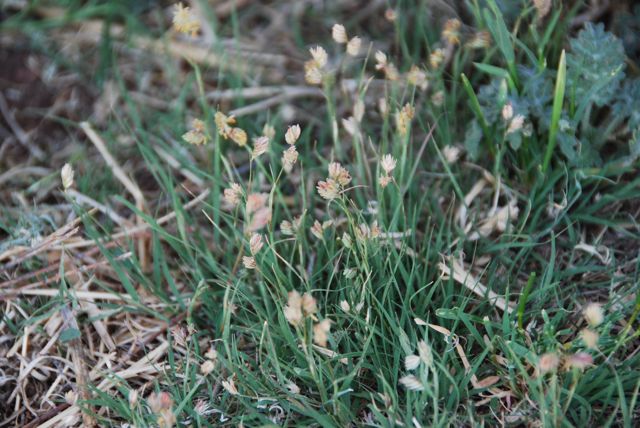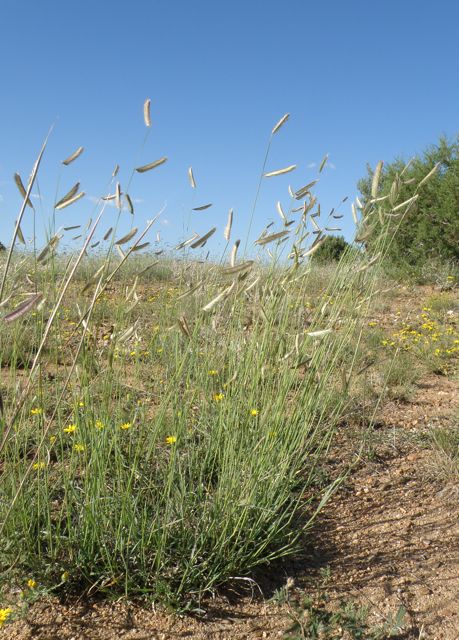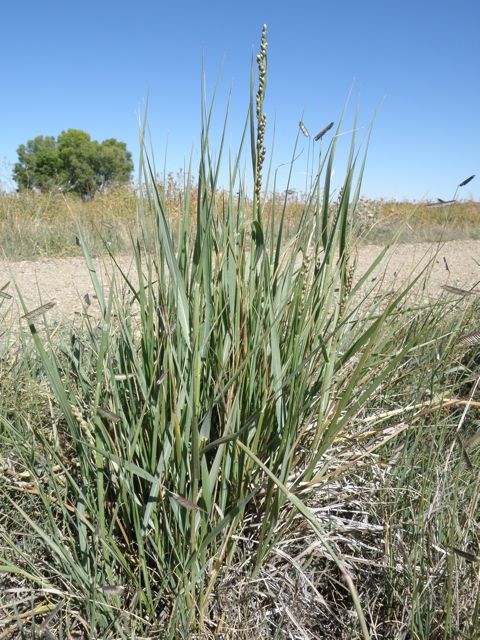 Slowing Erosion with Native Grasses - July 26, 2017 Jeff Schalau, Agent, Agriculture & Natural Resources University of Arizona Cooperative Extension, Yavapai County Erosion is a natural process, but ground disturbance can accelerate the rate of soil loss. To retard this effect, the soil surface should be protected by some form of cover. Erosion usually begins with raindrop impact. The energy released by the raindrop causes soil particle to go into suspension and move with the water. As flowing water accumulates, it forms rills and gullies that further accelerate soil erosion. Once flowing water slows, the energy dissipates and soil is left behind as sediment. This is called deposition. In landscapes, we usually want to retard erosion. However, bare areas are inevitably left behind following construction or other major disturbances. In many cases, erosion can be mitigated by using mulches. Rock, gravel, wood chips, and bark dissipate the energy of raindrop impact and allow the water infiltrate the soil surface and percolate through the soil. Soils have a limited capacity for absorbing water and during intense rainfall events we can expect some overland flow. Anytime unoccupied growing space is made available, some plant will eventually occupy this space. In ecology, this growing space is called a “niche”. Weeds are the pioneer species of ornamental landscapes and gardens. By anticipating these ecological processes, you can choose desirable plants that will occupy these niches instead of undesirable weeds. Perennial native grasses are a good choice for erosion control because they have fibrous root systems that bind soil together and will require little or no irrigation once they are established. Leaves and litter from grasses protect the soil from raindrop impact. Perennial grasses also increase soil organic matter and water infiltration rates. As roots die, their decomposition leaves behind organic matter and the empty spaces create voids where water can more easily flow into and through the soil profile. Grasses are usually classified as warm-season or cool-season species. This refers to the season in which they grow most readily. They are also classified into bunch grasses or sod forming species. Bunch grasses are frequently sold as ornamentals and create attractive accents in the landscape. Sod forming grasses spread horizontally through stolons (above ground shoots) and/or rhizomes (below ground shoots) and are preferable for erosion control due to their spreading growth habit. Warm season species are best planted during summer and cool season species are best planted in the fall. Choosing the correct species for your site and soils is another matter. Different soil types can affect the success (or failure) of native grass plantings. Since native grass seed can be expensive, I recommend doing some research on the native species that are present in your area. In the Verde Valley area, some desirable sod-forming grasses are buffalograss (Bouteloua dactyloides), vine mesquite (Panicum obtusum), and blue grama (Bouteloua gracilis). Deergrass (Muhlenbergia rigens), sideoats grama (Bouteloua curtipendula) and sand dropseed (Sporobolus cryptandrus) are native bunchgrasses. Deergrass has become very popular for use in landscapes and is widely available in nurseries. I transplant and divide individual grass plants of desirable native species from elsewhere on my property to new locations. I provided some irrigation to help them for the first year. It is important to transplant grasses during their season of active growth. You may also collect seed from native grasses. Collect seed heads only after they have cured (dried) on the plant. Shatter the seed heads in your hands and spread the shattered material in areas where you want that grass species to become established and rake the soil to ensure contact with the soil surface. Supplemental irrigation will promote better germination and establishment. Germination and subsequent growth is slow, but this process works well and the pruning is good for the mature grass plants. Grasses can be challenging to identify, even for trained botanists. Yavapai County Master Gardeners and other local collaborators have created a website called “Yavapai County Native & Naturalized Plants” which currently has photos and descriptions of 127 local grass species. The site is easily found using search engines or by entering https://cals.arizona.edu/yavapaiplants/ in your web browser. I have included a few photos from the site below. Once you visit the site, make sure you bookmark it for future reference. Follow the Backyard Gardener on Twitter – use the link on the BYG website. If you have other gardening questions, call the Master Gardener help line in the Camp Verde office at 928-554-8992 or e-mail us at verdevalleymg@gmail.com and be sure to include your name, address and phone number. Find past Backyard Gardener columns or provide feedback at the Backyard Gardener web site: http://cals.arizona.edu/yavapai/anr/hort/byg/. Photos  Buffalograss (Bouteloua dactyloides) growing at the V Bar V Ranch, Cedar Flat (from: Yavapai County Native and Naturalized Plants, https://cals.arizona.edu/yavapaiplants/, photo by John Kava).
Buffalograss (Bouteloua dactyloides) growing at the V Bar V Ranch, Cedar Flat (from: Yavapai County Native and Naturalized Plants, https://cals.arizona.edu/yavapaiplants/, photo by John Kava). Blue grama (Bouteloua gracilis) growing in Chino Valley, AZ (from: Yavapai County Native and Naturalized Plants, https://cals.arizona.edu/yavapaiplants/, photo by Sue Smith).
Blue grama (Bouteloua gracilis) growing in Chino Valley, AZ (from: Yavapai County Native and Naturalized Plants, https://cals.arizona.edu/yavapaiplants/, photo by Sue Smith). Vine mesquite (Panicum obtusum) growing near Granite Mountain, AZ (from: Yavapai County Native and Naturalized Plants, https://cals.arizona.edu/yavapaiplants/, photo by Sue Smith).
Vine mesquite (Panicum obtusum) growing near Granite Mountain, AZ (from: Yavapai County Native and Naturalized Plants, https://cals.arizona.edu/yavapaiplants/, photo by Sue Smith). |